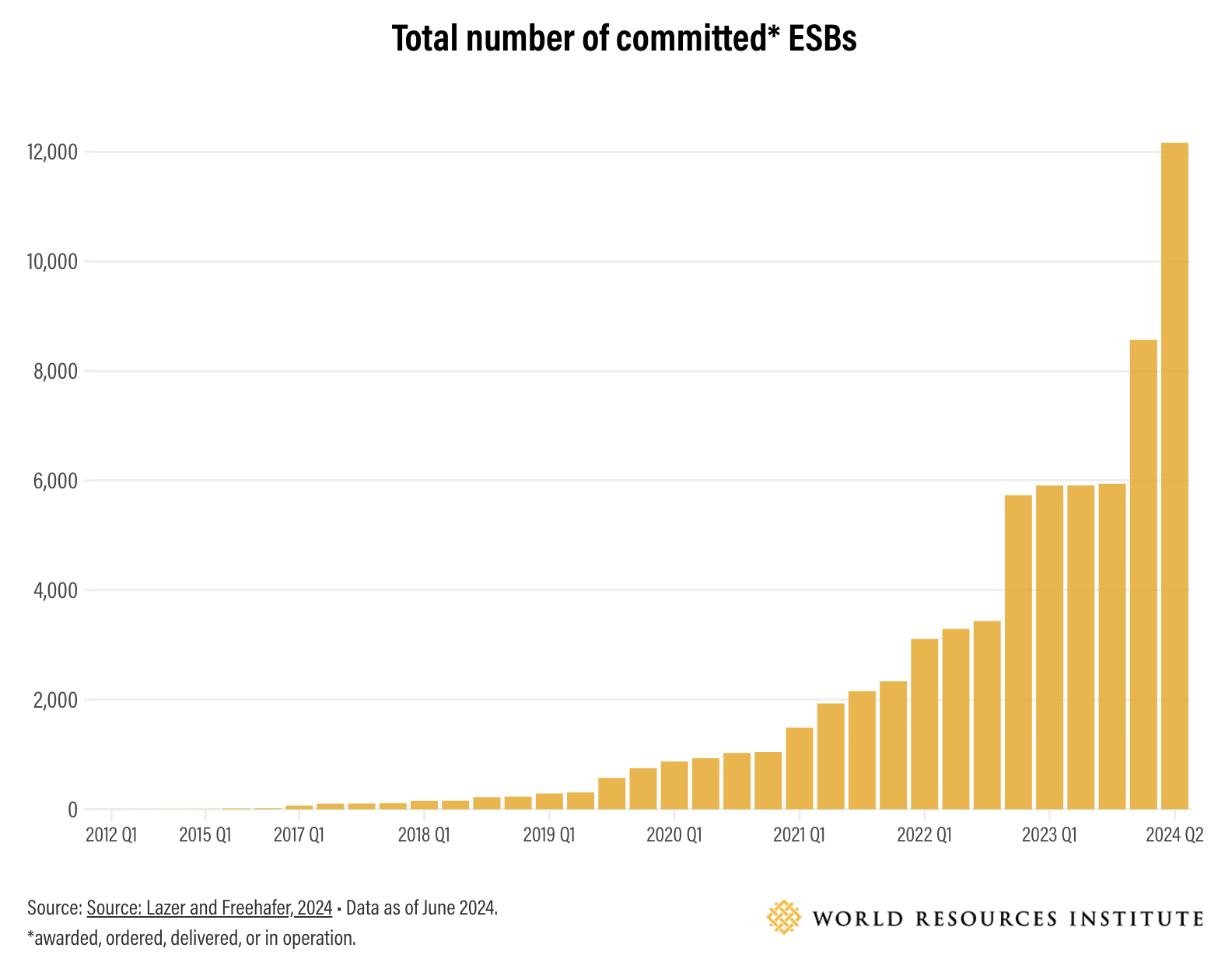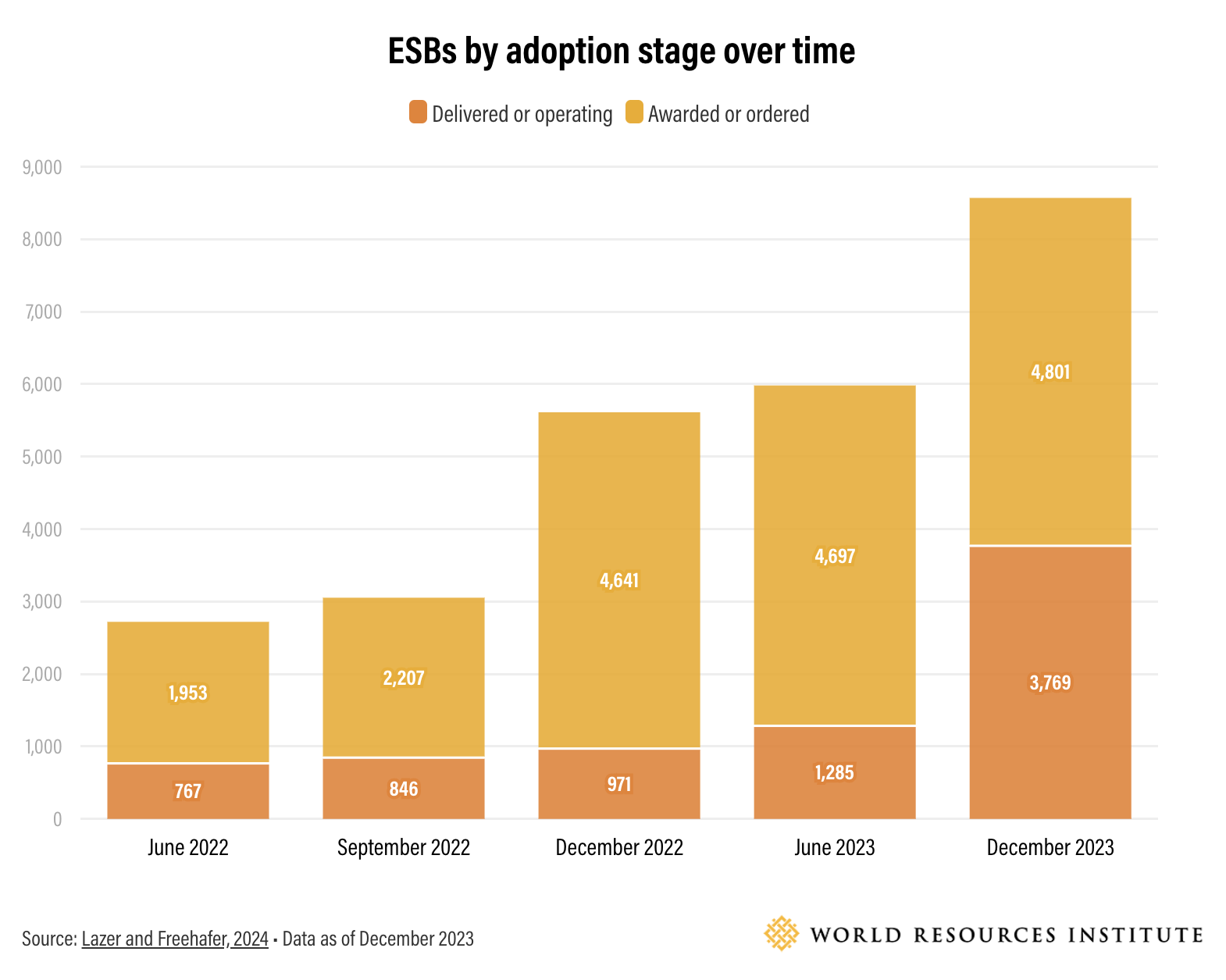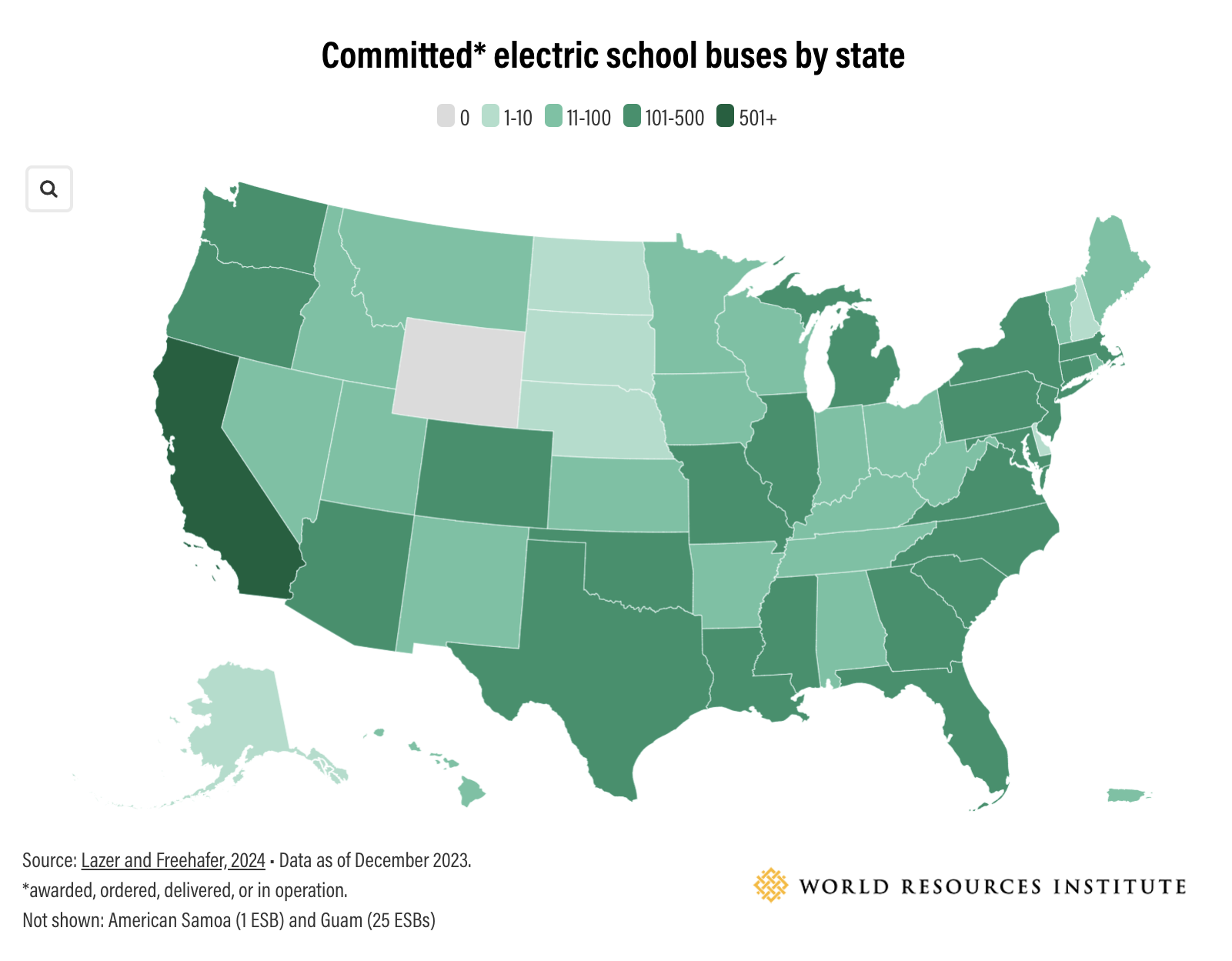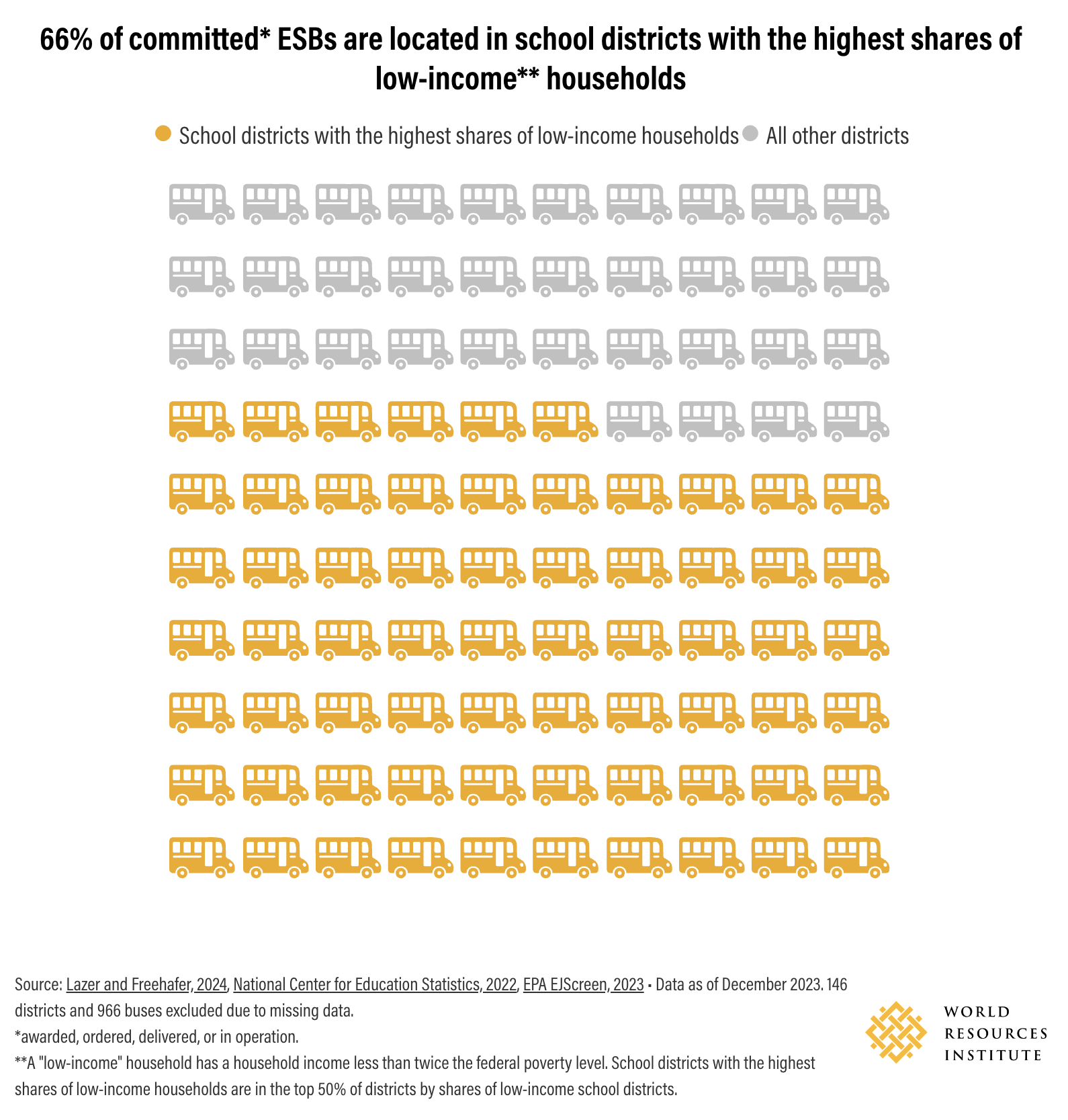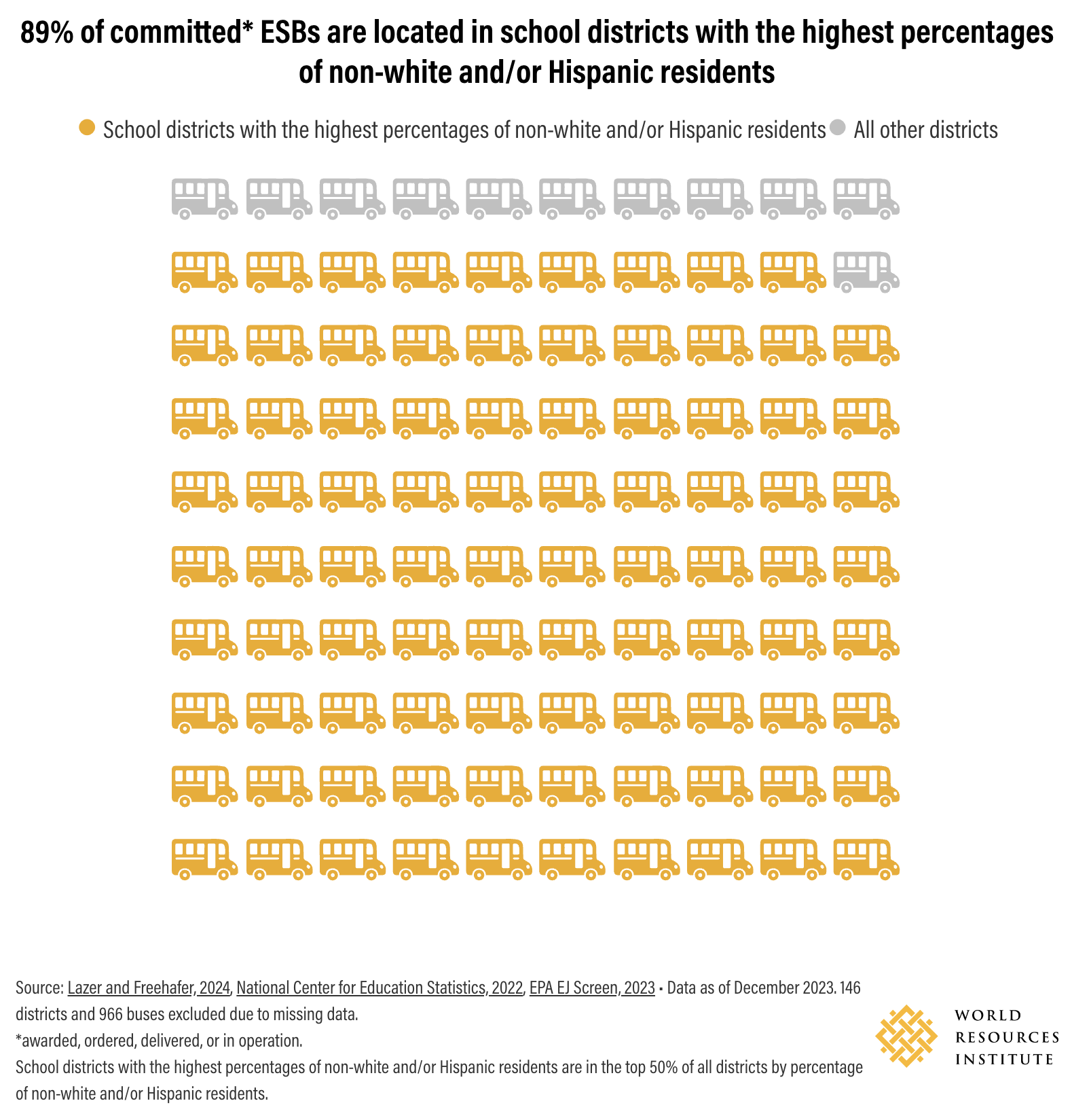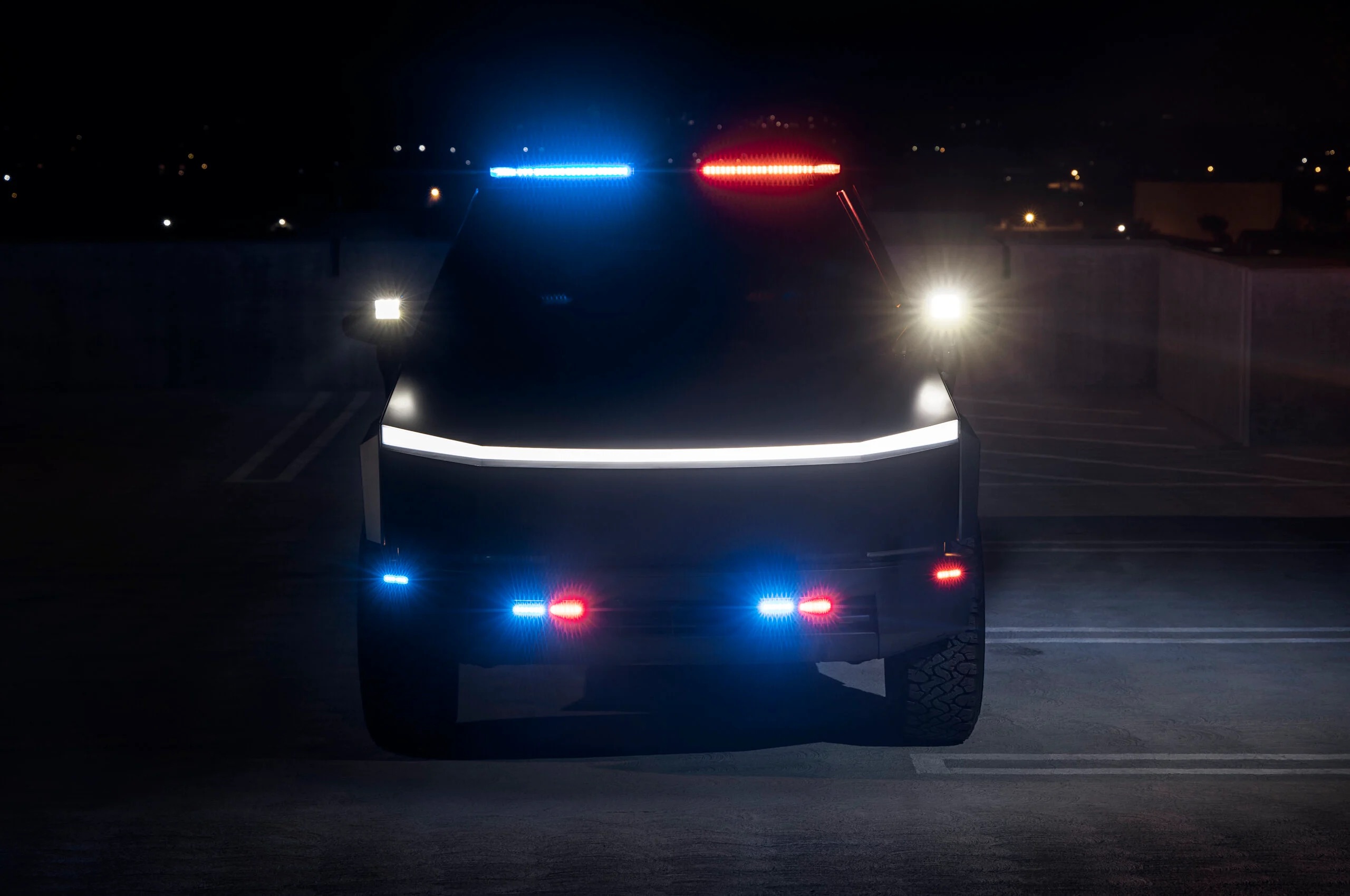Sign up for daily news updates from CleanTechnica on email. Or follow us on Google News!
Editor’s Note: This article was updated with new findings as of June 2024 from WRI’s Electric School Bus Data Dashboard and Dataset of Electric School Bus Adoption in the United States. The dashboard, updated monthly, reflects the most recent data on electric school bus adoption. The dataset, updated biannually, reflects data on electric school bus adoption as well as details about individual buses, school districts and student populations. Previous versions of this article are available for download at the bottom of this page.
More than 21 million children ride the bus to school in the U.S. and over 90% of these school buses run on diesel fuel, putting children’s health at risk every school day. Diesel exhaust is a known carcinogen, with proven links to serious physical health issues as well as cognitive development impacts. But with more electric school buses on the road, these risks can be reduced greatly.
Electric school buses have zero tailpipe emissions, preventing students’ exposure to harmful pollutants. Plus, electric school buses are cleaner for the environment, producing less than half the greenhouse gas emissions of diesel or propane-powered school buses, even after accounting for emissions for electricity generation from current sources.
Electric School Buses By the Numbers
As of June 2024, electric school bus adoption in the U.S. has grown to a total commitment of 12,164 buses since 2012. We consider an electric school bus “committed” when a school district or fleet operator has been awarded funding to purchase it or has made a formal agreement for a purchase with a dealer or manufacturer. Committed buses also include those in operation and those delivered to the school district or fleet operator. Approximately 200,000 students across the country are currently served by electric school buses.
Over two thirds (67%) of all committed electric school buses in the U.S. were funded by the Environmental Protection Agency’s (EPA) Clean School Bus Program, which awarded more than $900 million for nearly 2,300 electric school buses to 365 school districts in its first round of rebate funding in 2022. An additional $1 billion in Clean School Bus Program funding through a second round of grant funding released in January 2024 added approximately 2,700 more electric school buses in 270 school districts. And a third round of rebate funding announced last month selected nearly 500 school districts to receive $900 million in funds to replace diesel-fueled school buses with 3,177 electric buses.
Thanks to this program, there are now electric school bus commitments in 49 states, Washington, D.C., American Samoa, Guam, Puerto Rico, the U.S. Virgin Islands and several tribal nations including the Lower Brule Sioux Tribe, Mississippi Band of Choctaw Indians, Morongo Band of Mission Indians, the Soboba Band of Luiseño Indians and the Umo N Ho N Nation. This unprecedented level of funding comes from the Bipartisan Infrastructure Law of 2021 and would not have been possible without the tireless advocacy work of groups across the country.
The total number of electric school buses is also likely to expand considerably thanks to a fourth round of Clean School Bus Program funding planned to open later in 2024, as well as the EPA’s new Clean Heavy Duty Vehicles Grant Program, designed to help transition heavy duty vehicles — including school buses — to zero-emission models. EPA expects around 70% of the funding, or around $700 million, to support school bus replacement projects. Further, several states have passed laws and statutes to transition to zero-emission school buses, setting the stage for widespread electric school bus adoption.
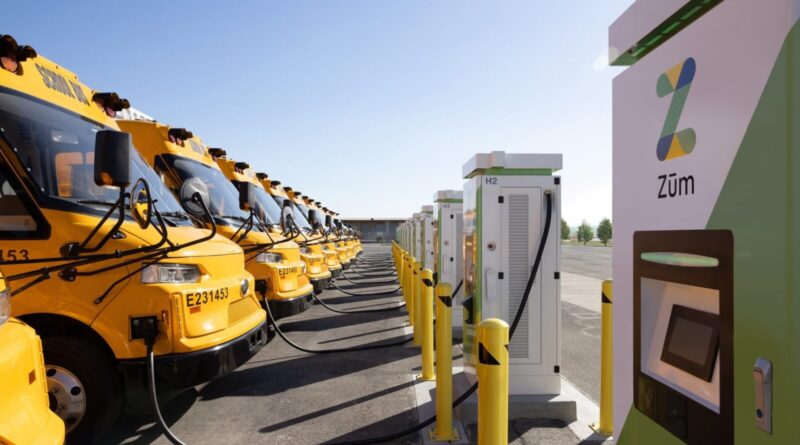
WRI has been tracking electric school bus adoption across the U.S. since Summer 2021. We recently released updated data covering the third and fourth quarters of 2023. This more comprehensive dataset allows us to better compare the data over time and identify specific trends as more electric school buses make their way to the road.
Here are the key findings from this updated dataset:
The U.S. has more than 3,500 Electric School Buses on the Road Today
As of December 2023, we identified 8,570 committed electric school buses across 1,132 U.S. school districts or private fleet operators. That’s more than triple the number of districts since our first count in the summer of 2021, while the amount of electric school buses committed has increased six-fold.
We collect data on four phases of the electric school bus adoption process that fit under the umbrella term “committed:” “awarded,” “ordered,” “delivered” and “in operation.”
As of December 2023, among the total number of committed buses, 5,117 are on order, delivered to the school district or already operating. An additional 3,453 buses have been awarded to school districts from federal and local government initiatives but have not yet been ordered or delivered.
Through our data tracking, we can see that school districts that receive electric school bus awards have significant follow-through. For example, as of December 2023, over 1,348 electric school bus awards have translated into bus orders.
Electric School Buses Are Committed in 49 States; Large Increases Were Seen in the Southeast
WRI’s third and fourth quarter 2023 dataset update shows every U.S. state, except Wyoming, has electric school bus commitments, as well as five tribal schools, one private school operated by a tribal nation, Washington, D.C., American Samoa, Guam, Puerto Rico and the U.S. Virgin Islands.
The updated data shows electric school bus commitments continue to become more evenly distributed across the country. When tracking first began, more than half of electric school bus commitments were in the West (based on U.S. Census regions). Now, the West represents 37% of committed electric school buses, only a little more than the South’s 34% share of commitments. The Northeast and the Midwest have 16% and 13% of committed electric school buses, respectively.
California continues to lead in electric school bus adoption, with over 2,300 committed electric buses across the state, of which nearly 70% are delivered or operating. This is more than five times as many buses as the next leading state, Illinois, with 418 commitments.
The remaining top 10 states with the most committed electric school buses include New York (406), Maryland (386), Florida (378), Virginia (302), Texas (301), Georgia (285), Pennsylvania (256) and New Jersey (245).
Georgia is now one of the top 10 states with the most committed electric school buses for the first time since tracking began.
California also had the largest increase since our last update in June 2023, with 319 new commitments. Illinois had the second largest increase with 208 new committed electric school buses. Other states that saw a significant jump since June 2023 include Georgia (157), Texas (154), Pennsylvania (144), Louisiana (128), North Carolina (122), and Florida (121). Much of these increases can be attributed to the EPA Clean School Bus Program funding. For example, 100% of electric school buses in Louisiana were funded by the program, as well as 99% in Georgia, 94% in Texas, and 42% in Florida. The southeast region of the U.S. now has around 1,400 committed electric school buses.
With approximately 5,000 electric school buses awarded as of December 2023 — and more on the way — the EPA’s Clean School Bus Program far surpasses any other single funding source by the number of buses funded. The next largest funding source comes from California’s Hybrid and Zero-Emission Truck and Bus Voucher Incentive Program (HVIP), which has funded 1,039 buses. Unsurprisingly, California-specific funding sources comprise half of the 10 largest funding sources. The state’s robust incentive programs are partly why 28% of all committed electric school buses in the U.S. can be found there.
Large Commitments for Electric School Buses Are Increasing
The growing number of commitments for more buses suggests increasing trust in electric school bus technology and market conditions, as well as wider funding availability.
Seventy five percent of the 1,132 U.S. school districts or private fleet operators with electric school buses by December 2023 have committed to more than one bus. Over one-third (39%) of all entities with electric school buses have committed to five or more and 243 (21%) have committed to 10 or more, compared to 60 school districts just one year ago. Ninety districts have electric school bus commitments that amount to 50% or more of their current fleet size.
Top 5 School Districts by Number of Electric School Buses Ordered, Delivered or Operating as of December 2023
Is Electric School Bus Adoption Occurring Equitably?
Students from low-income families are particularly exposed to the dangers of diesel exhaust pollution from school buses: 60% ride the bus to school, compared to 45% of students from families with higher incomes. In addition, Black students and children with disabilities rely on school buses more than their peers. Children of color are also more likely to suffer from asthma, due in part to historically racist lending, transit, housing and zoning policies that concentrated Black and Brown communities closer to highways and other sources of vehicle-based air pollution. Electrifying the entire fleet of school buses, and prioritizing these communities in the transition, can help address these concerns.
Before the EPA’s Clean School Bus Program awards in 2022, the largest percentage of electric school buses were in districts with the smallest shares of low-income households. By December 2023, 66% of committed electric school buses are in districts with the highest shares of low-income households.
Overall, committed electric school buses are largely concentrated in historically underserved school districts. Since tracking began, we have seen an increase in buses in low-income areas and areas with the highest levels of particulate matter (PM2.5) and ozone pollution. A majority of electric school buses continue to be in school districts with high populations of people of color.
Notably, the EPA’s Clean School Bus Program led to a more equitable distribution of electric school buses by prioritizing school districts based on whether they were “high need” (focusing on high-poverty districts and those located in the U.S. Virgin Islands, Guam, American Samoa or Northern Mariana Islands), rural, tribal or a combination of these criteria.
The share of districts with at least one electric school bus in each type of locale (rural, town, suburban and urban) also aligns closely to the distribution of all school districts nationwide among these locales. Thirty- six percent of school districts with at least one committed electric school bus are in rural locales, 25% are in urban, 24% are in suburban and 15% are in town locales.
The concentration of electric school buses in school districts with the highest shares of low-income households has increased significantly, mostly due to the Clean School Bus Program’s prioritization of low-income school districts.
Electric school bus adoption appears to be occurring equitably when looking at the distribution of vehicles among communities of color. Eighty-nine percent of committed electric school buses are in school districts with the highest percentages of people of color (defined as “people of color” in the EPA’s EJScreen data). The Clean School Bus Program did not use race or ethnicity as prioritization criteria, so policymakers, utilities, nonprofit organizations and teams charged with program design and implementation should commit to ensuring this trend continues.
WRI also evaluated data to see if electric school buses were equitably distributed across communities impacted the most by harmful pollutants. We compiled data on concentrations of PM2.5 and ozone in school districts because of their harmful health effects, their close linkage to diesel exhaust and the availability of data. The data shows school districts with the highest levels of PM2.5 air pollution have more committed electric school buses. Over two thirds of committed electric school buses are in school districts with the highest concentrations of PM2.5. The trend continues with ozone pollution. Almost three quarters of committed electric school buses are in districts with the highest concentrations of ozone pollution.
Last year, the Electric School Bus Initiative published the first nationwide dataset of asthma rates by school district based on census tract-level data from CDC PLACES and found that encouragingly, nearly 50% of electric school buses are in areas with high rates of adult asthma. This is especially important, as evidence suggests that children are especially susceptible to these impacts. Data on childhood asthma rates at the census tract level was not available.
As of December 2023, school districts with electric school buses are fairly evenly distributed among different levels of adult asthma rates. A little less than half (48%) of committed electric school buses are in school districts with the highest adult asthma rates.
Approximately 52% of committed electric school buses are in school districts with lower adult asthma rates. Efforts must continue to ensure that electric school buses are brought first to communities that will benefit the most from air quality improvements.
It’s important to note that the metrics presented here show only a few examples of equity measurements. WRI is also closely tracking other community characteristics including disability access and services and tribal equity to ensure there’s an equitable transition to electric school buses. Later this year, WRI anticipates the publication of a more in-depth analysis on the equity of electric school bus adoption revealing where the most polluting buses and fleets are located and who is most affected, as well as which districts have succeeded in procuring electric school buses thus far. WRI is committed to working alongside partners to ensure that underserved communities remain front-and-center in the transition.
What’s Next to Scale Up Electric School Bus Adoption?
With the recent EPA awards, more electric school buses are expected to be introduced across the U.S. through 2024. But that’s not the only government program putting more electric school buses on the road.
Last summer, the Internal Revenue Service (IRS) issued proposed regulations for elective payment options for claiming certain clean energy tax credits —which allows entities like school districts to claim electric school bus-relevant credits such as 45W (Qualified Commercial Clean Vehicles) and 30C (Alternative Fuel Vehicle Refueling Property Credit). School districts and other tax-exempt entities can now access these credits through the “elective” or “direct” pay mechanism.
These credits can save school bus operators tens and even hundreds of thousands of dollars on school bus electrification.
State legislatures are also bolstering the electric school bus transition. Since 2022, seven states have statutorily enacted zero-emission school bus transition requirements, including California, Connecticut, Delaware, Maine, Maryland, New York and the state of Washington. Around 100,000 diesel school buses (19% of the entire U.S. fleet) and 6 million school bus riders (26% of all riders) are impacted in these states.
Washington is the most recent state to enact its transition target in March 2024, requiring that 100% of new school bus purchases be zero-emission once the total cost of ownership is on par with that of diesel buses. The grant programs must also prioritize environmental justice communities.
Colorado, Michigan and Washington D.C., have non-binding transition goals, aiming for 100% zero-emission buses on the road by 2035, 100% of school bus sales to be electric by 2030 and the replacement of 100% of school buses with electric models beginning in 2021, respectively.
In March 2024, New Jersey’s Electric School Bus Grant Program, funded by the state’s Board of Public Utilities’ Clean Energy Fund, opened $45 million in grant funding over three years to replace diesel school buses with electric school buses, as well as to install associated charging infrastructure. Additional funding is available for school districts willing to participate in vehicle-to-building technology, which will enable electricity to flow from electric school bus batteries to school buildings.
This state-level progress has spurred the consideration of funding and fleet transition targets and propositions in other areas, including Hawaii, Illinois and Massachusetts.
The latest data shows that electric school buses have nationwide momentum. If progress toward an all-electric school bus fleet is to persist, policymakers at the federal and state levels, including state utility regulators, will need to continue establishing electric school bus enabling policies, such as fleet transition targets and programs to support charging infrastructure deployment. Federal and state governments can continue to address the upfront cost premium of electric school buses through new and augmented funding opportunities and, importantly, financing programs that help maximize the impact and reach of grants and leverage them for greater scale and ambition. Across these efforts, policymakers should ensure benefits are equitably accessible to communities that would benefit most from school bus electrification.
Looking to follow the most up-to-date, interactive electric school bus data? Check out our Electric School Bus Data Dashboard, where you can easily explore trends and dive into the latest data.
View past editions of this article:
By Lydia Freehafer, Leah Lazer, and Brian Zepka. Article from WRI.
Have a tip for CleanTechnica? Want to advertise? Want to suggest a guest for our CleanTech Talk podcast? Contact us here.
Latest CleanTechnica.TV Videos
CleanTechnica uses affiliate links. See our policy here.
CleanTechnica’s Comment Policy

